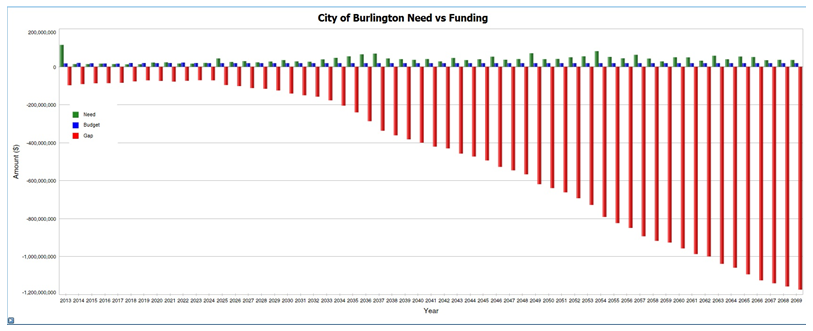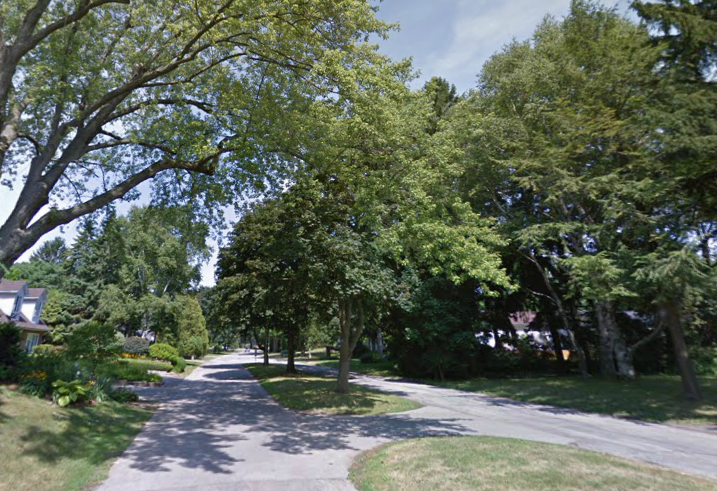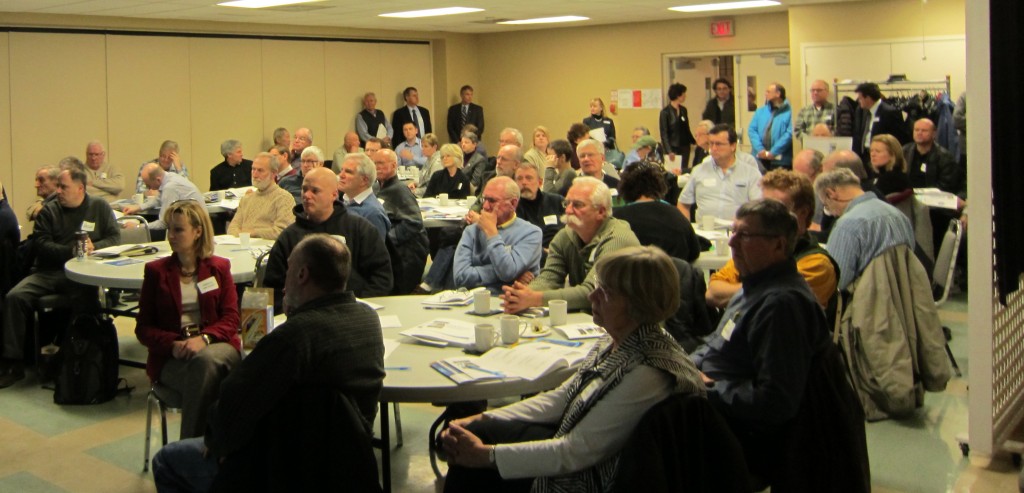BURLINGTON, ON.
February 4, 2014
Jeff Fielding has a problem. It’s a big problem. We aren’t sure exactly when he realized he had a problem nor do we know when he fully realized the extent of the problem. But there is no doubt today that he has got a firm grip on the problem and he can tell you exactly what it is with one simple graph.

The chart covers a long period of time and it is difficult to read the detail but the trend isn’t hard to miss. Those red lines represent the amount of money the city does not have but needs to spend if roads and other capital assets are to be maintained. Are there efficiencies anywhere?
Fielding will tell you that we aren’t in a desperate situation – yet, but he adds that if we don’t do something now – we will be in a close to desperate situation. The problem is with the asset’s the city owns.
In January of last year Fielding briefed Council corporate Asset Management Project. At that time Italo DiPietro and Paul Rohoman were seconded from Engineering to Corporate Strategic Initiatives to give the task the dedicated and focused attention it needed.
The city’s tangible capital assets, based on their replacement value is approximately $2.5 billion. Of this, approximately $2 billion is made up of linear assets including roads, storm sewers, bridges/culverts and sidewalks. A further $295 million is made up of city owned facilities and buildings. Collectively these two categories comprise approximately 92% of the city’s total capital assets as measured by replacement value.
 The objective of this project has been to report on the status of the city’s infrastructure, including adequacy of funding levels in the context of full life cycle needs. Following this, the project team would work with Finance staff on the analysis of funding scenarios and implications for the long-term condition of the city’s tangible capital assets.
The objective of this project has been to report on the status of the city’s infrastructure, including adequacy of funding levels in the context of full life cycle needs. Following this, the project team would work with Finance staff on the analysis of funding scenarios and implications for the long-term condition of the city’s tangible capital assets.
In the asset management world seven things matter:
1. What do we own and where is it? (Inventory)
2. What is it worth? (Costs and replacement rates)
3. What is its condition and expected service life? (Condition and capability analysis)
4. What do we need to do to it? (optimum preventative maintenance and rehabilitation)
5. When do you need to do it? (Capital and operating plans)
6. How much will it cost?
7. How do you ensure long-term affordability? (Short and long term financial plan and acceptable risk)
These are large numbers. This is arcane language – only something an account would get excited about. However, if one looks at the data in a format that is easy to understand it evokes an Are you kidding me?

Goodram looking north from LAkeshore: a classic Burlington Street that cost $2.9 million to rebuild just a portion of the street.
Last summer Goodram Street was rebuilt. The street was close to 60 years old and its best before date had passed – some time ago. So the city rebuilt the road, rebuilt the sidewalk and the sewers at a total cost of $2.9 million
There were 54 homes on the stretch of street that had the construction work done. Based on the tax revenue the city derives from those 54 homes it will be at least 24 years before the $2.9 million has been recovered. In the meantime of course the city has to provide the good people on Goodram the normal services anyone else gets.
That kind of mathematics is just not sustainable – which is why Jeff Fielding and his staff are looking for more efficient ways to run the city. Somehow we must get a grip on what we are spending on the assets we own.

Director of Finance Joan Ford does a great job of providing the data and her department does a good job of collecting the taxes as well. It’s the spending side that is causing the long term financial stress. Ms Ford doesn’t do the spending.
It is important to note, said a city Corporate Strategic Initiatives (CSI) report that asset accounting is different than asset management. The former is backward looking and is focused on developing an annual charge based on expected service life (amortization period) and depreciated cost based on the acquisition cost (net book value). It is not based on actual replacement cost or actual condition of the assets, and in many cases the actual inventory of assets has been pooled and does not give specific details on an asset itself. Asset management on the other hand is forward-looking and is focused on planning for the maintenance and renewal needs of an asset in the future. It is a management and capital planning methodology. Critical difference that impacts on the way Fielding has to find the money to pay for the replacements.
To provide a full long-term assessment of funding needs, a 60 year time horizon was used for both the facilities and buildings assets and roadways. Meeting new building code and accessibility requirements will add to the actual cost of projects.
 Based on this analysis, the existing backlog of now needs for facilities and buildings is estimated at $13.2 million. With existing funding levels a moderate backlog is forecast to persist on average over the next 25-30 year period.
Based on this analysis, the existing backlog of now needs for facilities and buildings is estimated at $13.2 million. With existing funding levels a moderate backlog is forecast to persist on average over the next 25-30 year period.
In the longer term, the forecast for facilities is shown to increase significantly, as long life building systems reach the end of the useful life. The extent of the cumulative backlog will be approximately $25 million at the end of the planning horizon approaching year 60.
Ouch!
The existing backlog of now need roads has been calculated at $105 million. The shave and pave program has extended the life of our roads but there is nothing that can extend them forever. Existing funding levels indicate a major deficit in approximately 2025 which is when a large volume of roads that will be at the end of their useful life and will require full reconstruction.
One of the objectives in the City’s Long Term Financial Plan is Predictable Infrastructure Investment. The city’s infrastructure is aging, and funds must be committed to ensure it is properly maintained and renewed. It is imperative that a strategy be developed in a way that ensures our assets are protected and maintained at minimum cost to the taxpayers.
There are several possible financing strategies available to address the issue of the existing backlog and the growing infrastructure funding gap. Capital from Current funding (Cash) is one of the preferred strategies. It requires detailed planning to ensure that funds can be collected over the life of the asset. . This option would require incremental increases to the city’s existing dedicated infrastructure levy. This would directly impact tax rate increases as well as restrict the ability to utilize property tax levies for other needs.
That last sentence needs to be read a second time. `… require incremental increases to the city’s existing dedicated infrastructure levy. This would directly impact tax rate increases as well as restrict the ability to utilize property tax levies for other needs.
Funds for new project would not be available.
In order to move towards a cash-based renewal program there may be a need to reduce the speed by which the city achieves the optimal life cycle funding level. Lifecycle spending levels may need to be slowed down to match funding capability, and new initiatives and programs restricted to match available funding. Despite these challenges, the cash funding option is preferred due to its sustainability.

A rapt audience listened to an overview of the 2014 budget. What they have yet to have explained to them is the desperate situation the city will be in ten years from now if something isn’t done in the next few years to figure out how we are going to pay for the maintenance of the roads we have.
The city`s reserve funds are improving but the city nevertheless got a “warning” rating when the last report was received.. Drawing upon reserves to fund infrastructure renewal will only be sustainable in the long run, if contributions are made on an annual basis from the tax base and other revenues.
Tax monies put into reserve funds is then not available for other projects.
As well, the city may want to establish a policy of maintaining a minimum balance on the capital reserve funds. This will allow the city to maintain financial flexibility and match funding required by other government grant programs without incurring additional debt.
The Parks & Recreation Department currently adds a surcharge on room rentals and programs at select locations. These funds are then held in a reserve fund for that facility’s capital renewal needs. The practice is not currently in place at all locations and the surcharge being collected is often insufficient to cover all renewal needs. The vast majority of other fees collected across the city are used solely to offset departmental operating costs and do not contribute to facility renewal. Should the city choose to rely more heavily on this source of funding, a review of current revenue policies would need to be conducted to establish where facility renewal costs could be recovered from rates and fees.
The city has recently been successful in the sale of naming rights at the new Haber Community Centre. Annual revenues from this sponsorship arrangement will be deposited in the facility’s reserve fund to be used towards future capital renewal. Additional private sector sponsorship arrangements such as these could be used to address facility renewal at other locations within the city. It should be noted that these options only address the city’s facility infrastructure needs and do not assist with the funding gap for other asset categories.

Lori Jivan, Acting coordinator of budget and policy patiently leads people through an explanation of the budget and the workbook the city created.
Debt financing is beneficial as it can be used to address immediate needs faster than waiting for cash reserves to be built up. However it comes with an additional interest expense. Debt follows the principle of “intergeneration equity”, as it spreads the costs over the taxpayers consuming the asset and the benefit of the capital project over a longer period.
The city has a current debt policy which restricts total debt charges to 12.5% of net revenues.
The city’s long term reliance on debt as a funding source for asset renewal should be phased out as asset renewal is a continual expense requiring a sustainable funding source. However, it may be necessary to incur debt financing in early years in order to include several critical life-cycle projects for which sufficient funds have not been fully set aside. It is also important to keep in mind that when considering the use of debt as a funding source, the city should ensure that it is being used in a fiscally responsible manner and should follow the recommendations of the City’s Long Term Financial Plan.
Other options are:
Divesting of underutilized assets – This option would include the review of assets owned by the city (land and buildings) with the objective of maximizing the value of these assets through sale, partnering on development or optimizing net lease costs received/paid by the city.
Development of other revenue sources. There is a potential to develop other revenue sources through the establishment of city owned development or service corporations.
![]() Transferring of assets to senior levels of government, for example roads rationalization with the Region.
Transferring of assets to senior levels of government, for example roads rationalization with the Region.
Burlington is not bringing in the new employment development. Commercial properties pay more in the way of taxes and cost the city less to service. Residential housing is a loss operation for the city: it costs more to provide the services home owners need than the city is able to collect in taxes.

Can the city manage its debt and the cost of the infrastructure by pushing some of it forward and having the next generation pay for some of what we need to fix in the next ten years? Could the city use a conversation that would look seriously at the options in front of us?
There is one more graph that offers some hope. We continually hear about the baby boomers that are going to retire and cost the city more to provide services for.
The chart above shows where the hope is. While there are millions of baby boomers there are even more millions of Millennials – young people who will want to live and work in Burlington. We need to ensure that there are jobs in the city for them and that Burlington is a city they will want to live in. But that`s 20 years down the road.



















I am sympathetic to City Manager Fielding.
By the same token … I don’t think one meeting, January 30th, for the purpose of disclosing $1.2–$1.3 Million of Brant Street Pier PARTIAL legal costs constitutes a ‘communications flurry’ of disclosures from Burlington Council and City Management.
I would also remind City Manager Fielding … He cannot assume responsibility for the Mayor’s function … and he would have to absorb a significant pay cut in order to assume the role.
The Mayor, since the 2010 election, has been mediocre in fulfilling his role as City Magistrate, although MANY citizens assumed Goldring had the capabilities.
Most citizens were relieved at the departure of his predecessor.
I intend to go directly to Ontario Ombudsman André Marin—Open Meeting Law Enforcement Team (OMLET)
My complaints run the entire gambit;
1. Wrong, unfair decisions
2. Bad service
3. Unfair policies/procedures
4. Delays
5. Unfair enforcement
The cost of building infrastructure is skewed towards building single family homes. Continuing our tradition of sprawl development is wasteful of land, infrastructure dollars and adds to car centric communities and unhealthy lifestyles. And, as pointed out in the article, is unsustainable.
Our development policy, mandated by the province, flies in contradiction to sprawl. We are mandated to create more livable, more densely populated cities. But developers who want to create multi-unit residences are financially punished by the current building fee structure.
The solution lies in getting City Hall to change its pricing practices to align with policy objectives. The solution is not in developing our green spaces north of the 407.
The seminar given by Dr. Pamela Blais at the Mayor’s ‘Inspire Burlington’ series in February of 2013 speaks directly to this point. The seminar was a real eye opener. She states there are no impediments to changing this structure. Markham does it for one. What is lacking is desire / leadership.
Her book, ‘Perverse Cities’, should be required reading for all City Hall staffers in a management or leadership position, and Councillors.
I hope that Mr. Fielding and his team are looking at Dr. Blais’ research. Hi-lites of her talk are on the Mayor’s blog page: https://bit.ly/1fEl4Ec (A 2 minute video and article are on the page)
The ‘Inspire Burlington’ series is a great eye-opener for those of you who attend. I know that at least 2 Councillors and the Mayor were present at Dr. Blais’ speech.
Asset Rationalization is something this city should have been doing 10 years ago, especially when the greenlands were being consumed and the development charge revenue was destined to decline significantly.
Where was the collective brain at council while awaiting this tsunami? Goldring is a financial guy, and should understand basic math; but, the understanding of public revenue generation rests in real estate development and economic development. Nobody at this city knows anything about either. Also, are these numbers projected on the basis of NPV or, just simple math which will distort the actual figures even more significantly.
You also have this sort of stagnant mentality in the city, largely promoted by the likes of councillor John Taylor and his followers, who resist development encroachment north of the 407, and their refusal to understand the strategic economic importance of that highway’s extension.
Then you have the planning department’s ideology that maintaining a pregnant surplus of employment lands is the right thing to do.
One of the most immediate options to at least partially deflate this deficit is rationalizing with the Region. It is well known that the Region has a relatively healthy cash reserve extracted from DCs; in the billions apparently.
In the meantime, the city’s real estate department should be sharpening its pencils and conducting some due diligence and presenting business case justifications for extracting value out of a comprehensive asset rationalization program. A thorough assessment of the opportunities could be easily conducted within a 6-12 month time frame, while at the same time there could be advancements made with the Region, as well as the building of a collective political will within the council chambers to be more proactive and embrace the benefits of an aggressive development plan.
Give a developer a hug today and tell them how much we need them.
The Burlington Performing Arts Centre took so much of our money and continues to take $500,000+ per year to maintain. I was against it and the mistake by the lake pier 15 years ago and many of us told council we need to look after our infastructure first before tossing taxpayers money on luxuries. Heads should roll.